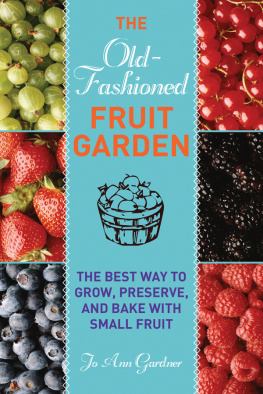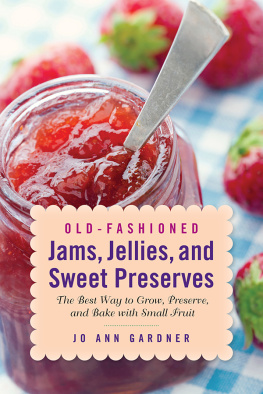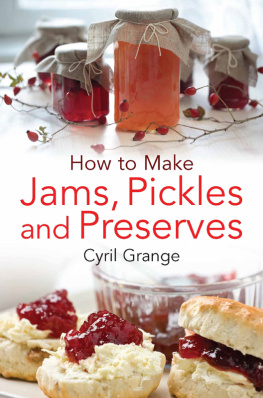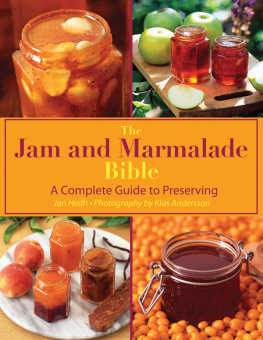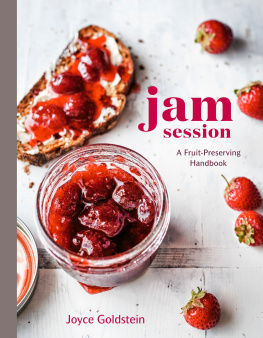
THE
Old Fashioned
FRUIT GARDEN

Copyright 1989, 2012 by Jo Ann Gardner
Originally published in Canada by Nimbus Publishing
All Rights Reserved. No part of this book may be reproduced in any manner without the express written consent of the publisher, except in the case of brief excerpts in critical reviews or articles. All inquiries should be addressed to Skyhorse Publishing, 307 West 36th Street, 11th Floor, New York, NY 10018.
Skyhorse Publishing books may be purchased in bulk at special discounts for sales promotion, corporate gifts, fund-raising, or educational purposes. Special editions can also be created to specifications. For details, contact the Special Sales Department, Skyhorse Publishing, 307 West 36th Street, 11th Floor, New York, NY 10018 or .
Skyhorse and Skyhorse Publishing are registered trademarks of Skyhorse Publishing, Inc., a Delaware corporation.
www.skyhorsepublishing.com
10 9 8 7 6 5 4 3 2 1
Library of Congress Cataloging-in-Publication Data available on file.
ISBN: 978-1-61608-621-3
Printed in China
This fruit of my labor is dedicated to Jigs,
beloved partner in all things.
To those who joy in their work,
this old earth laughs with them.
Samuel Fraser, 1924
Contents
Authors Noteson a New Edition
O ver forty years ago, in 1971, we moved ourselves, our four children, and a Noahs Ark of animals to a remote farm at the northeastern tip of Nova Scotia, to Cape Breton Island. We wanted to own a piece of earth where we could grow our food and keep some poultry and livestock, as we had been doing at rented farms. We were tired of planting strawberries and not being around to harvest them because the landlord sold the place where we were living, but with the money we saved we hadnt been able to afford anything suitable in the northeastern U.S. where Jigs and I had always lived.
We had no idea, really, of what we would be up against in Cape Breton: long, gray, maritime winters of freezing and thawing; heavy clay soil, slow to warm and leached of nutrients; and wind... oh, the wind, enough to blow our little greenhouse roof off, not once, but three times. I know, because I helped, in a roaring wind, to nail it back down.
I havent mentioned income, because for the first five years, we hadnt any. We lived on our savings, and we lived a very lean life. After the first year, the bad roads shook up our old truck so much we abandoned it and used our team of horses wherever we needed to go, not very far. I called our backlands farm the No Capitol of the World: no vehicle, no running water (Jigs, ever creative, tells me it did run... out of the hand pump), and no phone. We did have electricity, but not a very sound system and we did not tax it much. We heated and cooked solely with wood and we had no freezer.
But there is no reason to be sorry for those years. We learned so much. Not only about Canada, and Cape Breton and its folk culture, of which we were sublimely ignorant, but about ourselves and how far we could stretch our abilities. In 1978 when the youngest of our children left the farm, I found myself to be the only other hand on staff. With no prior experience (I graduated from Bennington, majoring in drama and literature), with pitchfork in hand, standing on the hay wagon that Jigs drove around the field, I learned to build tons of hay each summer and helped to unload them in the barn. I pulled at the other end of a cross-cut saw to cut down huge trees for firewood... when Jigs pointed in the direction I was to run after the tree cracked, you can be sure I ran fast. I learned to spread manure by moonlight with the team of horses after a day in the woods, a day that also included barn chores (milking, cleaning out pens, feeding, and watering) and cooking three big meals a day.
Those were also the years of enormous fruit harvests. Early on, we had built two log cabins for guests to bring in some income, and before breakfast, they might pick buckets of gooseberries or baskets and baskets of raspberries that had to be turned to account as fast as I could manage. With no freezer, I adapted older recipes to suit my circumstances; readers may appreciate how I dispensed with topping and tailing gooseberries. And somehow I managed not only to preserve the fruit harvest but produce superior products. What I learned became the source of inspiration for The Old-Fashioned Fruit Garden, the first edition of this book, published in 1989.
A lot has happened in the intervening years. In 2001, for one thing, we moved back to the States, to the foothills of the Adirondacks, in New Yorks Champlain Valley. We live now in a converted one-room schoolhouse with 10, instead of 100 acres of land, and we keep flocks of poultry. We still maintain large gardens that mostly feed us, we raise as much fruit as we can, and we still enjoy foraging in the wild. The principles that unconsciously drove ussimplicity, economy, and self-relianceare still in practice, imprinted on our souls. Looking back, I see that we were green when green was just a color, but we didnt live green on principle. Our lives grew out of our preferences. We followed a path of our own desire. Whatever we did and however we have lived, for better or for worse, there is no pretension about it. It just is.
A lot has happened, too, in the field of fruit development. There are many new varieties (more correctly, cultivars) among traditional June-bearing, everbearing, and day-neutral strawberries, for instance, so that the home gardener has the possibility of harvesting more than one crop a season; the same is true of raspberries, among the fall-bearing type. And blackberries are coming along with similar characteristics.
Among fruit trees, there are more semi-dwarf types that take up far less room than standards, and there are even some that can be grown in tubs. Blueberries, a beautiful bush in flower, whose leaves turn bright scarlet in the fall, have been the subject of breeding and selection to find ever more beautiful and productive varieties.
In general, the breeding trend is toward fruits that are not only productive, disease and insect resistant, and adaptable to different conditions, but ones that have ornamental value. Landscaping with edibles is definitely a trend among home gardeners.
Today, a significant number of gardeners are interested in growing less common fruits. As Tim Malinich, Extension Educator of the Lorain County Extension Office in Ohio told me, Ten years ago, if I did a talk and mentioned elderberries or currants a few people would have had experience or interest. Today, a significant number of gardeners either have experience with or are willing to work with less common fruits such as currants, elderberries, and gooseberries. In fact, it is becoming almost trendy to grow them. Their health benefits, too (along with blueberries), have been in the news, altogether giving these fruits a higher profile.
This new edition of The Old-Fashioned Fruit Garden takes into account all these trendsin fruit breeding and interest in the less common fruitsand offers one of the most comprehensive collections of recipes and directions for preserving and using currants (including a hefty section on black currants), gooseberries, and elderberries, for these were the very fruits that were the backbone of our Cape Breton gardens. What was old-fashioned is now new. I have added quince to the mix, an old-fashioned tree that seems to me elegant enough to grow just for looks, but I do include recipes.
Next page
